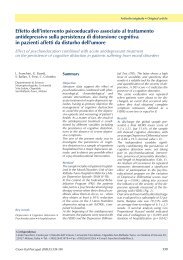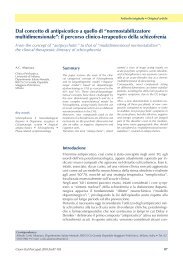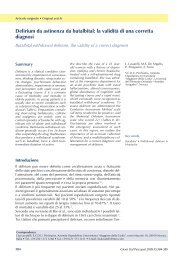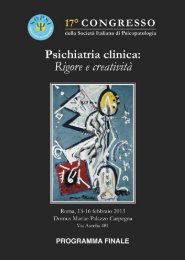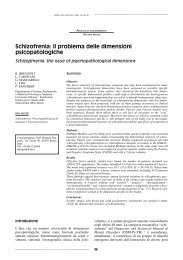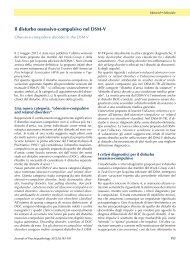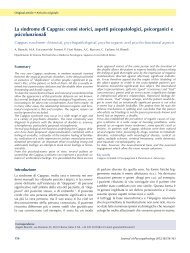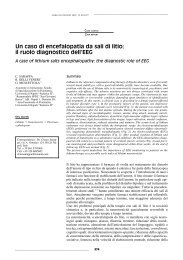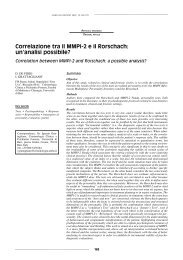XI Congresso della Società Italiana di Psicopatologia Psichiatria ...
XI Congresso della Società Italiana di Psicopatologia Psichiatria ...
XI Congresso della Società Italiana di Psicopatologia Psichiatria ...
Create successful ePaper yourself
Turn your PDF publications into a flip-book with our unique Google optimized e-Paper software.
Bipolar II Disorder: the link between Bipolar<br />
I Disorder and Major Depressive Disorder?<br />
Z. Rihmer<br />
National Institute for Psychiatry and Neurology, Budapest<br />
The separation of unipolar depression from bipolar (manicdepressive)<br />
<strong>di</strong>sorder has been well accepted for decades,<br />
and the sub<strong>di</strong>vision of bipolar <strong>di</strong>sorder further into Bipolar<br />
I (depression with a history of mania) and Bipolar II (depression<br />
with a history of hypomania but not with mania)<br />
subgroups has been also supported by several clinical and<br />
biological fin<strong>di</strong>ngs. Given the three <strong>di</strong>fferent levels of mood<br />
and acitivty state in Bipolar II <strong>di</strong>sorder, phenomenologically<br />
it is more close to Bipolar I <strong>di</strong>sorder than to Unipolar depression.<br />
In spite of this, family stu<strong>di</strong>es and clinical investigations<br />
(inclu<strong>di</strong>ng treatment-response stu<strong>di</strong>es) have demonstrated<br />
a significant overlap between Bipolar II <strong>di</strong>sorder and<br />
Unipolar major depression.<br />
Investigating the external bipolar validators (family history<br />
of bipolar <strong>di</strong>sorder, age of onset, depressive mixed states,<br />
DSM-IV atypical features and treatment-associated hypomania)<br />
in Unipolar major depression, the fin<strong>di</strong>ngs strongly<br />
suggest that a subset (around one-third) of Unipolar major<br />
depressives is more close to Bipolar II <strong>di</strong>sorder than to<br />
Unipolar depression, in<strong>di</strong>cating that they belong to the bipolar<br />
spectrum. Bipolar II <strong>di</strong>sorder should be considered as a<br />
bridge between Bipolar I <strong>di</strong>sorder and Unipolar Major Depressive<br />
Disorder.<br />
References<br />
1 Akiskal HS, Benazzi F. J Affect Disord 2003;73:113-22.<br />
2 Benazzi F. World J Biol Psych 2003;4:166-71.<br />
3 Rihmer Z, Pestality P. Psych Clin N Am 1999;22:667-73.<br />
Similarities and <strong>di</strong>fferences between<br />
bipolar and depressive <strong>di</strong>sorders<br />
E. Vieta<br />
Bipolar Disorders Program, Hospital Clinic, University of<br />
Barcelona, IDIBAPS, Barcelona<br />
The <strong>di</strong>stinction between unipolar and bipolar forms was first<br />
described by Leonhard (1957) and subsequently validated<br />
by Angst (1966), Perris (1966) and Winokur et al. (1969),<br />
who showed that clinical, familial and course features supported<br />
the nosological <strong>di</strong>fferentiation between unipolar and<br />
bipolar <strong>di</strong>sorders (Angst and Marneros, 2001). However,<br />
there are many areas of overlap between those extremes,<br />
pointing up the question of possible clinical subtypes in the<br />
interface of depressive and manic extremes of affective illness<br />
(Akiskal, 2002; Benazzi, 2005).<br />
Bipolar <strong>di</strong>sorder occurs in multiple forms and degrees of<br />
severity. The recognition of the existence of so-called<br />
milder forms of manic-depressive illness has been a major<br />
endeavour in the last decade. The <strong>di</strong>stinctions hinge on the<br />
classification of elated states and this poses some <strong>di</strong>fficulty<br />
because it depends on the arbitrary gradation of severity<br />
and duration. Bipolar <strong>di</strong>sorder with mania and strict unipolar<br />
depression without manic or hypomanic episodes would<br />
represent the extremes of a spectrum (Akiskal, 1983); re-<br />
43<br />
SIMPOSI TEMATICI<br />
current depressions with hypomania would occupy a middle<br />
territory (Akiskal, 2002). The exploration of spectrum<br />
models of manic depressive illness would enhance research<br />
on genetic markers and modes of genetic transmission,<br />
would provide an approach for identifying in<strong>di</strong>viduals at<br />
risk for the development of bipolar illness, and would permit<br />
the evaluation of treatments for milder forms, inclu<strong>di</strong>ng<br />
the question of whether early intervention could lessen the<br />
chance of progression to bipolar illness (Vieta et al., 2005).<br />
In fact, a great number of in<strong>di</strong>viduals with the so-called soft<br />
or subsyndromal states belong to the bipolar spectrum by<br />
virtue of their positive family histories, their pharmacological<br />
response and their tendency to progress to full clinical<br />
<strong>di</strong>sorder. All these issues will be <strong>di</strong>scussed in the presentation.<br />
Mixed states: a link between bipolar and<br />
unipolar <strong>di</strong>sorders?<br />
A. Koukopoulos<br />
Centro “Lucio Bini”, Roma<br />
In Kraepelin’s conception mixed states consisted of a mixture<br />
of depressive and excited symptoms i.e they were bipolar<br />
syndroms as we would say today.<br />
With our present nosology a problem arises about the position<br />
of agitated or mixed depressions and its meaning for the<br />
unipolar-bipolar <strong>di</strong>stinction of depressive syndromes.<br />
In a sample of 212 patients suffering from agitated depression<br />
(152 women, 60 men) 56 (27%) were BPI, 66 (31%)<br />
were BPII, 22 (10%) sufferd only from mixed depressio but<br />
68 (32%) of them were unipolar depressive patients i.e they<br />
never had manic/hypomanic episodes before.<br />
In 64 (30%) patients the agitated depression was followed<br />
by a simple inhibited depression without mixed symptoms.<br />
37 (30%) were bipolar patients and 22 (32%) were unipolar<br />
depressives. This type of sequence is similar to the<br />
manic-depressive cycle. The identical proportion of bipolar<br />
and unipolar depressive patients that follow this evolution<br />
gives further support to the thesis that agitated depression<br />
is a mixed state and it can occur in unipolar depressive<br />
patients.<br />
La continuità tra Disturbo Bipolare<br />
e Depressione Ricorrente: implicazioni<br />
terapeutiche<br />
G. Perugi<br />
Dipartimento <strong>di</strong> <strong>Psichiatria</strong>, Università <strong>di</strong> Pisa, Istituto <strong>di</strong><br />
Scienze del Comportamento “G. De Lisio”, Pisa<br />
Introduzione: negli ultimi anni a seguito <strong>di</strong> una definizione<br />
nuova e più ampia <strong>di</strong> spettro bipolare si è andata delineando<br />
una continuità sintomatologica tra forme bipolari e depressive<br />
ricorrenti. In questa sede ci si propone <strong>di</strong> valutare le<br />
possibili implicazioni terapeutiche <strong>di</strong> tale continuità.<br />
Metodologia: ricerca <strong>della</strong> letteratura su PubMed con parole<br />
chiave spettro bipolare, continuità unipolare-bipolare e ricerca<br />
manuale <strong>di</strong> capitoli <strong>di</strong> libri ed articoli su riviste non in<strong>di</strong>cizzate.




